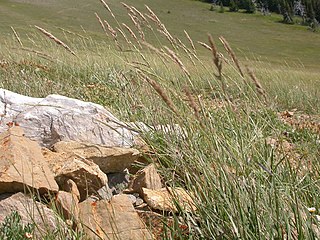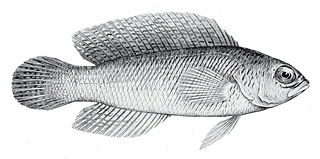
Salvia officinalis, the common sage or sage, is a perennial, evergreen subshrub, with woody stems, grayish leaves, and blue to purplish flowers. It is a member of the mint family Lamiaceae and native to the Mediterranean region, though it has been naturalized in many places throughout the world. It has a long history of medicinal and culinary use, and in modern times it has been used as an ornamental garden plant. The common name "sage" is also used for closely related species and cultivars.

Calamagrostis purpurascens, is a perennial grass commonly known as purple reedgrass, purple pinegrass, or alpine reedgrass. It grows 30 to 80 centimetres (31 in) tall.

The elm cultivar Ulmus 'Purpurea', the purple-leaved elm, was listed and described as Ulmus Stricta Purpurea, the 'Upright Purpled-leaved Elm', by John Frederick Wood, F.H.S., in The Midland Florist and Suburban Horticulturist (1851), as Ulmus purpureaHort. by Wesmael (1863), and as Ulmus campestris var. purpurea, syn. Ulmus purpureaHort. by Petzold and Kirchner in Arboretum Muscaviense (1864). Koch's description followed (1872), the various descriptions appearing to tally. Henry (1913) noted that the Ulmus campestris var. purpureaPetz. & Kirchn. grown at Kew as U. montana var. purpurea was "probably of hybrid origin", Ulmus montana being used at the time both for wych elm cultivars and for some of the U. × hollandica group. His description of Kew's U. montana var. purpurea matches that of the commonly-planted 'Purpurea' of the 20th century. His discussion of it (1913) under U. campestris, however, his name for English Elm, may be the reason why 'Purpurea' is sometimes erroneously called U. procera 'Purpurea' (as in USA and Sweden.

The Field Elm cultivar Ulmus minor 'Purpurascens' was listed by Lavallée in Arboretum Segrezianum (1877) as U. campestris var. purpurascens (purpurea), but without description, and later by Schneider in Illustriertes Handbuch der Laubholzkunde (1904). Krüssmann in Handbuch der Laubgehölze (1962) identified it as a cultivar.

The purple indigobird is a species of bird in the family Viduidae. It is also known as the dusky indigobird, a name which can refer to Vidua funerea. It is found in Angola, Botswana, Democratic Republic of the Congo, Kenya, Malawi, Mozambique, South Africa, Tanzania, Zambia, and Zimbabwe. Its natural habitat is dry savanna.
The bearded eelgoby, also known as the bearded goby, is a species of goby endemic to South Africa where it inhabits muddy areas of mangrove swamps, estuaries and rivers. This species can reach a length of 12 centimetres (4.7 in) TL.
Taenioides is a genus of gobies native to fresh, brackish, and marine waters of the coastal areas of the Indian Ocean and the western Pacific Ocean.

The Macquarie shag, Macquarie Island shag or Macquarie Island cormorant, is a marine cormorant native to Macquarie Island in the Southern Ocean, about halfway between Australia and Antarctica.

Taenioides cirratus,the Bearded worm goby, is a species of worm goby native to the Indian Ocean and the western Pacific Ocean from islands offshore of eastern Africa to New Caledonia and from Japan to Australia. This species can be found in estuaries and coastal waters, preferring areas with mud substrates feeding on small crustaceans and other invertebrates. It is capable of surviving in air for a considerable period by sucking air into its bronchial chambers probably to move over land. This species can reach a total length of 30 cm (12 in).

Cypho purpurascens. the oblique-lined dottyback or the lavender dottyback is a species of ray finned fish from the family Pseudochromidae which occurs in the western Pacific. It occasionally makes its way into the aquarium trade. It grows to a size of 7.5 centimetres (3.0 in) in length. These fish live in pairs, or are solitary, in or in the vicinity of crevices in the reef and holes located in tidal pools, lagoons and on the reef slopes.

Tasmannia purpurascens, commonly known as the broad-leaved pepperbush or purple pepperbush is a shrub in the primitive family Winteraceae and is only found growing in the Barrington Tops and Ben Halls Gap regions of New South Wales. It is locally abundant in a restricted subalpine habitat with a high rainfall, often growing in the ecotone in association with Antarctic Beech.

Amblyopinae is a subfamily of elongated mud-dwelling gobies commonly called eel gobies or worm gobies; it has been regarded as a subfamily of the family Gobiidae, while the 5th edition Fishes of the World classifies it as a subfamily of the family Oxudercidae. The members in the subfamily have two dorsal fins that are connected by a membranous structure and their eyes are highly reduced in size. They are usually pink, red, or purple in coloration.

Gloeocantharellus purpurascens, commonly known as the Indian Creek mushroom or violet-staining chanterelle, is a species of fungus in the family Gomphaceae native to North America and French Guiana.

Eremophila purpurascens, commonly known as purple eremophila, is a flowering plant in the figwort family, Scrophulariaceae and is endemic to Western Australia. It is an erect, bushy shrub with warty leaves and spotted, pink to red flowers.

The Elm cultivar Ulmus 'Myrtifolia Purpurea', the Purple Myrtle-leaved Elm, was first mentioned by Louis de Smet of Ghent (1877) as Ulmus myrtifolia purpurea. An U. campestris myrtifolia purpureaHort. was distributed by Louis van Houtte in the 1880s, by the Späth nursery, Berlin, in the 1890s and early 1900s, and by the Hesse Nursery, Weener, Germany, till the 1930s.

Leptospermum purpurascens, commonly known as the purple-stemmed turkey bush, is a shrub or small tree that is endemic to far north Queensland. It has bark that is purple when new, elliptical to broadly lance-shaped leaves, relatively small white flowers arranged in pairs and small fruit that falls from the plants when the seeds are released.
Goodenia purpurascens is a species of flowering plant in the family Goodeniaceae and is native to northern Australia and New Guinea. It is usually a perennial herb with linear to lance-shaped leaves at the base of the plant, and thyrses or panicles of purple flowers.

Bergenia purpurascens, the purple bergenia, is a species of flowering plant in the family Saxifragaceae. It is a perennial herb and is native to Nepal, the eastern Himalayas, Assam, Tibet, south-central China, and Myanmar. The species, its putative variety Bergenia purpurascens var. delavayi, and its cultivar 'Irish Crimson' have all gained the Royal Horticultural Society's Award of Garden Merit. A useful feature in the garden is the visual interest that its foliage provides by turning a deep beet red during the winter. The Latin specific epithet purpurascens is in reference to the foliage that is purple in color.

Daviesia purpurascens, commonly known as purple-leaved daviesia, is a species of flowering plant in the family Fabaceae and is endemic to the south-west of Western Australia. It is a glabrous shrub with many branchlets, scattered, erect, cylindrical, sharply pointed phyllodes and yellow and maroon flowers.

Epacris purpurascens is a species of flowering plant in the heath family Ericaceae and is endemic to eastern New South Wales. It is an erect shrub with egg-shaped or heart-shaped, sharply-pointed leaves and white or pink, tube-shaped flowers.

















